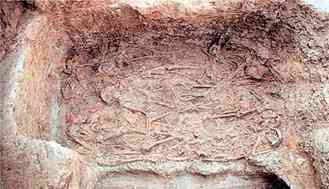In heaven's name, what happened? The Colosseum was struck by thunderbolts ...and such a blaze followed that its entire upper circuit and everything in the arena was consumed, and the rest of the structure was ravaged by the flames and reduced to ruins. Neither human aid could avail against the conflagration, though practically every aqueduct was emptied, nor could the downpour from the sky, which was most heavy and violent, accomplish anything....
You can't say it wasn't foretold.
As Roman newspapers were quick to report, a mule gave birth to a mule and a sow to a piglet with four ears, two tongues and eight feet. While, on the other side of the Palatine, bees formed honeycombs in the heart of the cattle-market. It was all too much. Gladiatorial games are postponed indefinitely.
Oh sorry, that was in 217 C.E. And the intrepid reporter was Cassius Dio (79.25).
But after dark tonight, the Colosseum will go up in flames again.
A huge virtual inferno is set to blaze inside the building, while flames flickering through the Colosseum's arches will be visible down to the far end of the Roman Forum.
Who's Fiddling Now?
 On the nights of 17, 18, and 19 September you can take in an extraordinary video installation conceived by the artists Thyra Hilden (Denmark) and Pio Diaz (Argentina): video screens placed in the arches of the Colosseum will make it appear as if the amphitheatre is on fire.
On the nights of 17, 18, and 19 September you can take in an extraordinary video installation conceived by the artists Thyra Hilden (Denmark) and Pio Diaz (Argentina): video screens placed in the arches of the Colosseum will make it appear as if the amphitheatre is on fire. Hilden and Diaz achieve this fantastic illusion by displaying a pre-recorded video of real fire on a scale of 1:1 using a series of powerful projectors. By digitally manipulating the footage, they create the effect of wind blowing through the monument in a wave of flames.
The 'Colosseum on Fire,' is part of a wider project, City on Fire, to which the artists have devoted themselves to for some years, creating virtual fires in important institutions, monuments, museums, and churches throughout Europe.
This is how the young artists explain their pyromaniacal urges:
This world is on fire. Modern life and technological development wipe away our cultural roots and heritage. Throughout history, we have torn down to build up. Cultural evolution involves destruction. Damage and destruction can be fertile, like the Italian Futurists preached before they experienced the terror of World Wars. Fire is an obvious symbol for this ambiguous process. Fire is an irrational, uncontrollable destroying force or a warm embracing source. Fire is also a symbol of spiritual transcendence and personal transformation - or terrifying acts by man destroying life and civilization.Over the last four years, the Danish-Argentine artist couple has been working with the city of Rome to realise the ultimate site for this project, and following intense negotiations, the pieces have finally fallen into place. Tonight, the Colosseum will burn!
"This multimedia installation will create an amazingly realistic impression of the Colosseum in flames," said the installation's curator, Gianni Mercurio. "The artists' aim is to show just how fragile and transitory mankind's creations are, even great buildings that are considered symbols of eternal culture."
But beware Gianni, beware Rome!
As the Venerable (even if pseudo) Bede prophesied in the 8th century:
As long as the Colosseum stands, so shall Rome; when the Colosseum falls, Rome shall fall; when Rome falls, so falls the world.Meanwhile, enjoy the spectacle.
My thanks to the EternallyCool website for the heads-up on this imminent project.
Illustrations
Top left: EternallyCool
Lower left: from the artists' webpage, City On Fire





